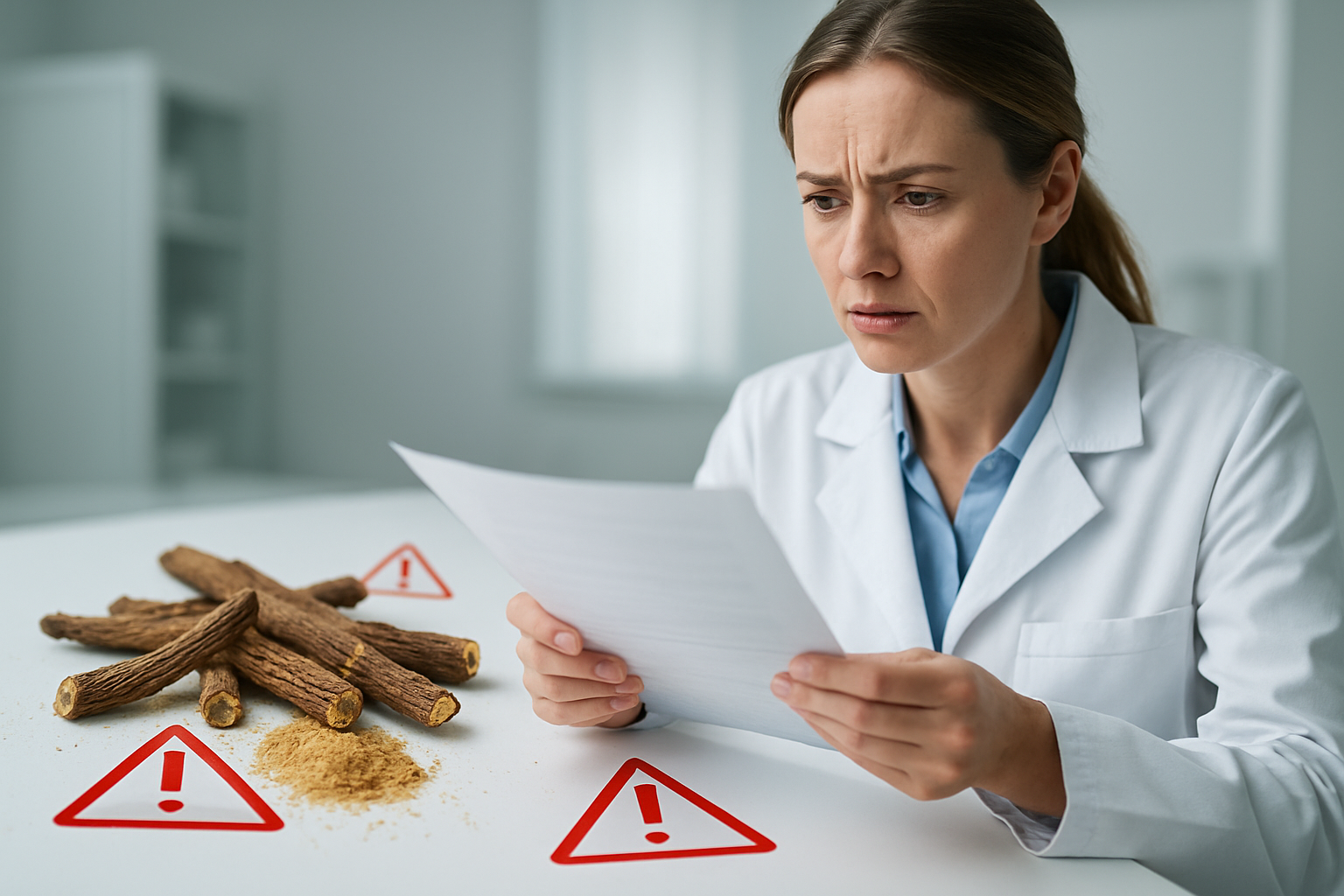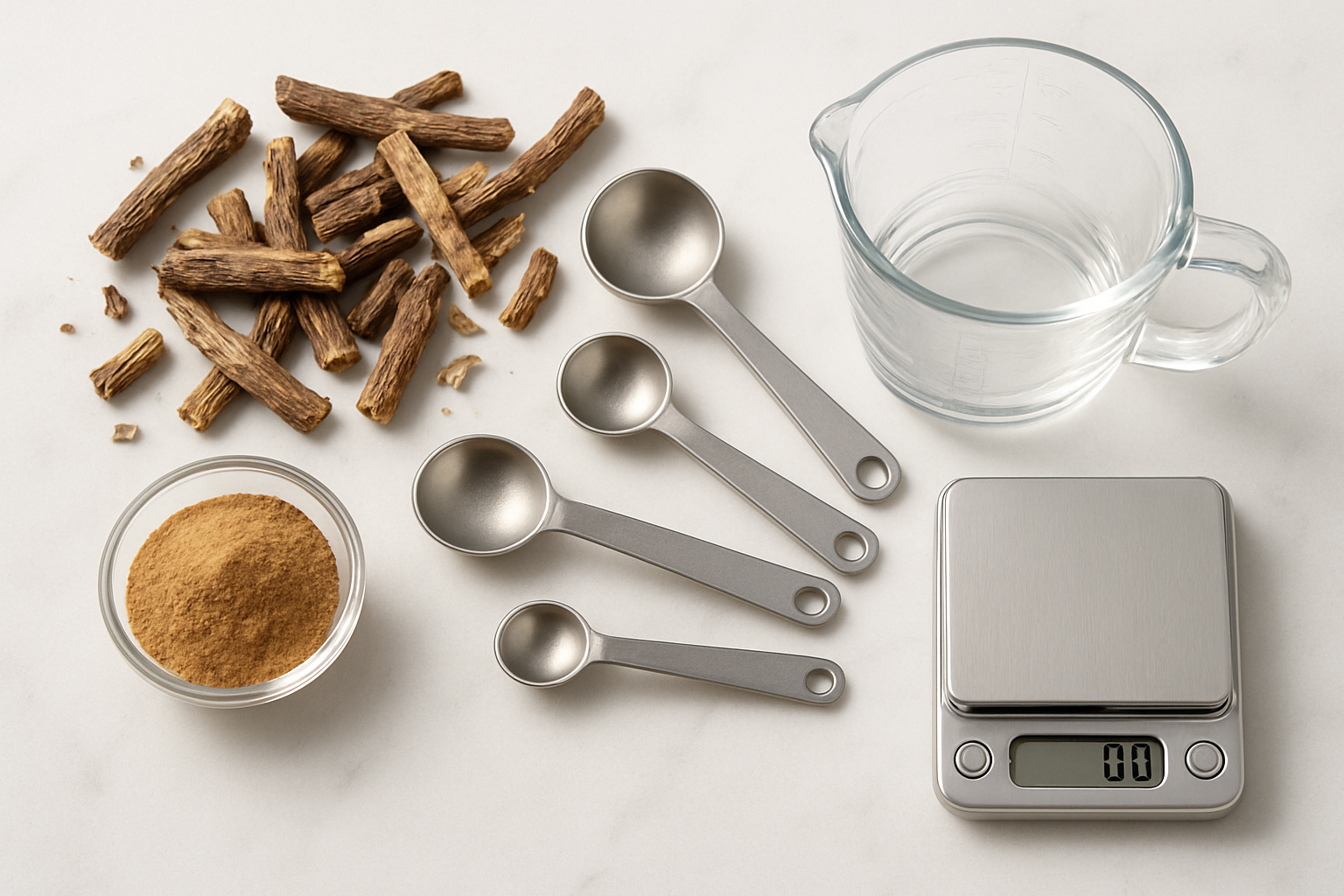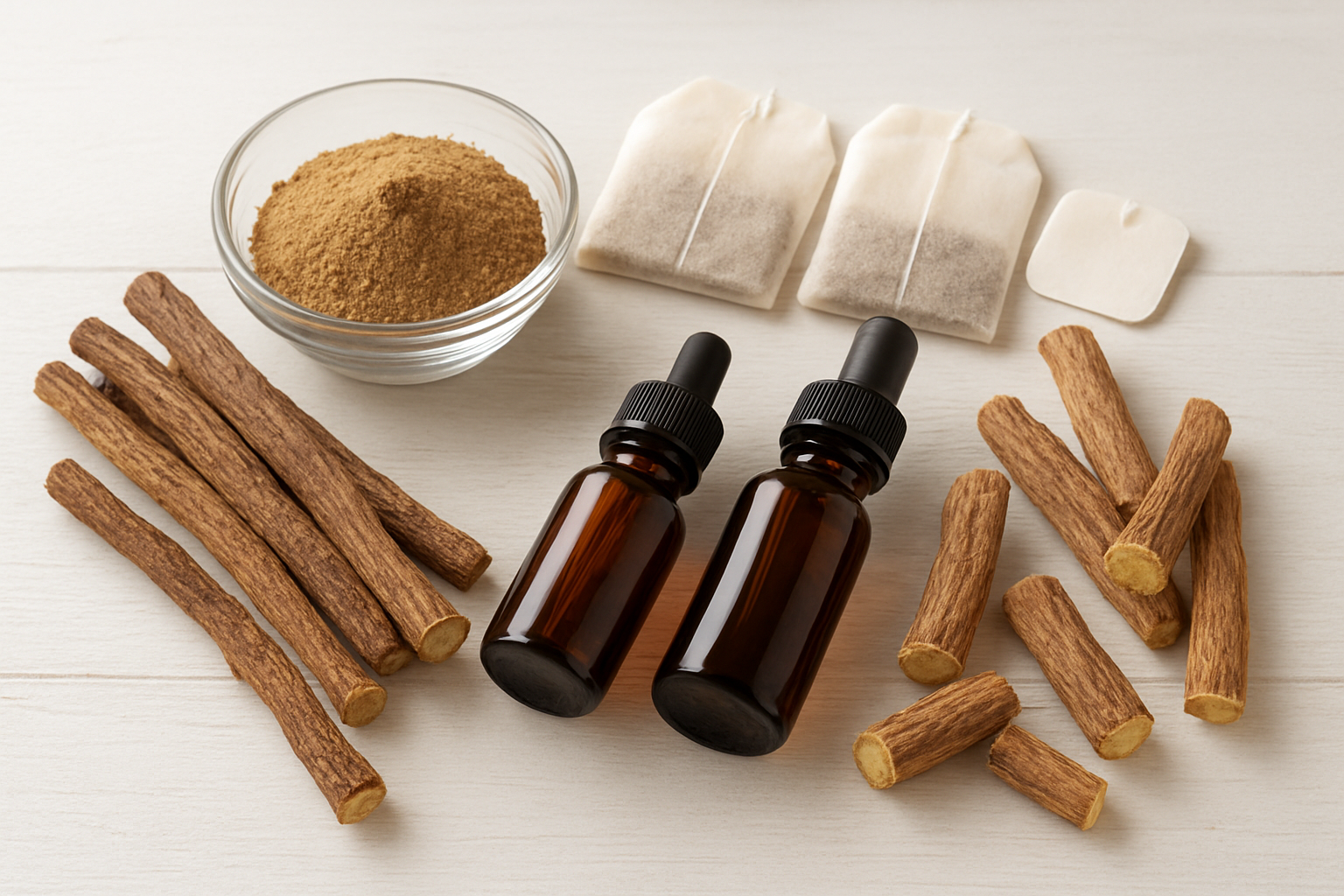Licorice root has been used for thousands of years as both a natural sweetener and herbal remedy, but many people don’t know about its impressive health benefits or potential risks. This guide is for anyone curious about adding licorice root to their wellness routine, from beginners exploring natural remedies to experienced users wanting to make sure they’re using it safely.
We’ll explore the science-backed health benefits of licorice root, including its anti-inflammatory and digestive properties. You’ll also learn about the potential side effects and who should steer clear of this powerful herb. Finally, we’ll cover safe dosage guidelines and the different forms available, so you can choose the right option for your needs.
Proven Health Benefits of Licorice Root

Soothes Digestive Issues and Stomach Ulcers
Licorice root contains glycyrrhizin, a compound that acts like a natural protective coating for your digestive system. This powerful substance helps heal stomach ulcers by reducing acid production and creating a barrier that shields damaged tissue from irritation. Studies show that deglycyrrhizinated licorice (DGL) can be just as effective as conventional medications for treating peptic ulcers, without the harsh side effects.
The root also stimulates mucus production in your stomach lining, which serves as an additional layer of protection against acid damage. People dealing with gastritis, heartburn, or acid reflux often find relief within just a few weeks of regular use. The anti-inflammatory properties work to calm irritated tissues throughout your entire digestive tract, making it helpful for conditions like inflammatory bowel syndrome.
Reduces Inflammation Throughout the Body
The anti-inflammatory effects of licorice root extend far beyond your digestive system. Glycyrrhizin mimics cortisol, your body’s natural anti-inflammatory hormone, helping to reduce swelling and pain in joints, muscles, and organs. This makes it particularly valuable for people with arthritis, as regular consumption can decrease joint stiffness and improve mobility.
Research demonstrates that licorice root extract can lower inflammatory markers in your blood, including C-reactive protein and interleukin-6. These compounds are linked to chronic diseases like heart disease, diabetes, and autoimmune conditions. The root’s flavonoids also contribute to its anti-inflammatory power, working at the cellular level to prevent damage from free radicals.
Supports Respiratory Health and Cough Relief
Licorice root has been a go-to remedy for respiratory issues for thousands of years, and modern science backs up this traditional use. The root acts as an expectorant, helping to thin and loosen mucus in your airways so you can cough it up more easily. This makes breathing clearer and more comfortable when you’re dealing with bronchitis, pneumonia, or persistent coughs.
The antimicrobial properties in licorice root help fight off bacteria and viruses that cause respiratory infections. Glycyrrhizin also reduces inflammation in your bronchial tubes, which can ease symptoms of asthma and chronic obstructive pulmonary disease (COPD). Many people find that drinking licorice tea or taking supplements during cold and flu season helps them recover faster and experience less severe symptoms.
Balances Hormones and Adrenal Function
Your adrenal glands produce cortisol to help you handle stress, but chronic stress can exhaust these important organs. Licorice root supports adrenal health by mimicking cortisol’s effects, giving your glands a chance to rest and recover. This can help restore energy levels, improve sleep quality, and reduce feelings of burnout or fatigue.
The root also influences other hormones, particularly in women. It contains compounds called phytoestrogens that can help balance estrogen levels, potentially easing symptoms of menopause like hot flashes and mood swings. Some research suggests licorice root may also support healthy testosterone levels in men, though more studies are needed to confirm this effect. The adaptogenic properties help your entire endocrine system function more efficiently, promoting better overall hormonal balance.
Potential Side Effects and Health Risks

Blood Pressure Elevation and Heart Problems
Licorice root contains glycyrrhizin, a compound that can seriously mess with your cardiovascular system. When you consume licorice regularly, this compound blocks an enzyme called 11β-hydroxysteroid dehydrogenase, which normally helps regulate cortisol levels in your kidneys. Without this enzyme working properly, your body starts retaining sodium and water while losing potassium.
This creates a perfect storm for high blood pressure. Your blood volume increases from all that extra fluid retention, putting more pressure on your arteries. People who eat licorice candy daily or take licorice supplements can see their blood pressure spike to dangerous levels within just a few weeks.
The heart problems don’t stop there. Some people develop irregular heartbeats, chest pain, and even heart failure from excessive licorice consumption. Case studies have documented people ending up in emergency rooms with severe cardiac issues after eating large amounts of black licorice candy or taking concentrated licorice supplements.
Your risk increases significantly if you already have heart disease, high blood pressure, or take medications like diuretics or heart rhythm drugs. Even healthy adults can develop serious cardiovascular complications when they consume more than 100 grams of licorice candy daily or take high-dose supplements.
Potassium Depletion and Muscle Weakness
Licorice consumption can drain your body’s potassium stores, leading to a condition called hypokalemia. When your potassium levels drop too low, your muscles can’t function properly. This affects everything from your skeletal muscles to your heart muscle.
Early signs of potassium depletion include muscle cramps, weakness, and fatigue. You might notice your legs feeling heavy or experience difficulty climbing stairs. Some people develop muscle pain or stiffness that seems to come out of nowhere.
As potassium levels continue dropping, the symptoms get worse. Severe cases can lead to:
- Complete muscle paralysis
- Breathing difficulties
- Dangerous heart rhythm abnormalities
- Kidney damage
- Seizures
The muscle weakness often starts in your arms and legs but can progress to affect the muscles you need for breathing. This creates a medical emergency requiring immediate hospitalization and potassium replacement therapy.
Athletes and people who exercise regularly face higher risks because they’re already losing potassium through sweat. Adding licorice consumption to the mix can push their potassium levels dangerously low, affecting both performance and health.
Hormonal Imbalances and Pregnancy Concerns
Licorice root acts like a hormone disruptor in your body, particularly affecting cortisol and sex hormones. The glycyrrhizin compound mimics some effects of cortisol, throwing off your body’s natural hormone balance.
Women often experience menstrual irregularities, including missed periods, heavy bleeding, or unpredictable cycles. Some develop symptoms similar to hormonal disorders, like unexplained weight gain, mood swings, or changes in body hair growth patterns.
Pregnancy brings even more serious concerns. Research shows that consuming licorice during pregnancy can affect fetal brain development and increase the risk of preterm labor. Studies have found that children whose mothers consumed licorice during pregnancy showed:
- Lower IQ scores
- Increased hyperactivity and attention problems
- Higher rates of anxiety and depression
- Earlier onset of puberty
Even small amounts of licorice can be problematic during pregnancy. The European Food Safety Authority recommends that pregnant women avoid licorice entirely, not just limit their intake.
Men aren’t immune to hormonal effects either. Regular licorice consumption can lower testosterone levels, potentially affecting libido, muscle mass, and overall energy levels. Some men develop gynecomastia (breast tissue enlargement) from prolonged licorice use.
People taking hormone replacement therapy or medications that affect hormone levels should be especially cautious, as licorice can interfere with these treatments and make hormonal imbalances worse.
Safe Dosage Guidelines and Recommended Amounts

Daily Intake Limits for Different Forms
The safe dosage of licorice root varies significantly depending on the form you’re using. For dried licorice root powder, most experts recommend staying between 1-5 grams daily. If you’re using standardized licorice root extract, the typical range drops to 250-500 milligrams per day.
Liquid extracts require even smaller amounts – usually 2-4 milliliters daily, while tinctures should be limited to 2-5 milliliters. DGL (deglycyrrhizinated licorice) tablets offer a safer option for longer-term use, with doses ranging from 380-1140 milligrams taken before meals.
| Form | Daily Dosage | Notes |
|---|---|---|
| Dried root powder | 1-5 grams | Split into 2-3 doses |
| Standardized extract | 250-500 mg | Look for 20% glycyrrhizin |
| Liquid extract | 2-4 ml | Mix with water |
| Tincture (1:5) | 2-5 ml | 3 times daily |
| DGL tablets | 380-1140 mg | Before meals |
Duration of Use Recommendations
Short-term use presents fewer risks than extended consumption. For most people, using licorice root for 4-6 weeks is considered relatively safe when staying within recommended doses. However, many herbalists suggest taking breaks – using licorice for 3-4 weeks, then stopping for 1-2 weeks before resuming if needed.
Long-term daily use beyond 6 weeks increases the risk of side effects, particularly those related to glycyrrhizin content. If you need licorice for chronic conditions, DGL forms allow for extended use since they remove most glycyrrhizin while preserving other beneficial compounds.
People using licorice for digestive issues often see results within 2-4 weeks, while respiratory benefits may appear within days. Starting with lower doses and gradually increasing helps your body adjust and reduces the chance of adverse reactions.
Factors That Affect Safe Dosing
Your individual tolerance depends on several key factors. Body weight plays a role – larger individuals typically handle higher doses better than smaller people. Age matters too, as older adults and children under 12 should use significantly lower amounts or avoid licorice entirely.
Existing health conditions dramatically impact safe dosing. People with high blood pressure, heart disease, kidney problems, or liver issues need much lower doses – sometimes as little as half the standard recommendation. Pregnancy and breastfeeding require complete avoidance of glycyrrhizin-containing forms.
Current medications create important interactions. Blood pressure medications, diuretics, blood thinners, and diabetes drugs can all interact with licorice, requiring dose adjustments or complete avoidance. Hormone medications, including birth control pills, may also be affected.
Your overall health status influences how your body processes licorice compounds. People with robust cardiovascular health typically tolerate standard doses well, while those with compromised systems need extra caution and professional guidance.
Different Forms and Preparation Methods

Dried Root Tea Preparation
The traditional way to enjoy licorice root involves brewing dried root pieces into a warming, naturally sweet tea. Start with one teaspoon of dried, chopped licorice root per cup of water. Bring water to a rolling boil, then reduce heat and add the root pieces. Let the mixture simmer for 10-15 minutes to extract the beneficial compounds. The longer you steep, the stronger and sweeter the tea becomes.
Strain out the root pieces before drinking. You can reuse the same root pieces 2-3 times, though each subsequent brew will be milder. Store unused dried root in an airtight container away from light and moisture. Quality dried root should have a distinctive sweet aroma and light brown color.
Liquid Extracts and Tinctures
Liquid extracts offer concentrated licorice root benefits in convenient dropper bottles. These alcohol-based or glycerin-based preparations contain higher concentrations of active compounds than tea. Typical dosing ranges from 1-3 droppers full, diluted in water or juice.
Alcohol-based tinctures have longer shelf lives and better extract fat-soluble compounds, while glycerin tinctures taste sweeter and work well for those avoiding alcohol. Look for products that specify glycyrrhizin content, as this helps you control your intake of this potent compound. Quality extracts should be dark amber or brown and have a distinctly sweet, slightly bitter taste.
Capsules and Standardized Supplements
Capsulated licorice root provides precise dosing and eliminates the strong taste some people find overwhelming. These supplements come in various forms:
- Whole root powder capsules: Contains the full spectrum of compounds found naturally in the root
- Standardized extracts: Concentrated to specific percentages of glycyrrhizin or glycyrrhetinic acid
- DGL (Deglycyrrhizinated Licorice): Has glycyrrhizin removed to reduce side effects while preserving other beneficial compounds
Capsules typically contain 400-500mg of licorice root powder or 75-150mg of concentrated extract. Always check the label for standardization information and third-party testing verification.
Topical Applications for Skin Conditions
Licorice root works effectively when applied directly to skin problems. You can create a simple paste by mixing licorice root powder with water or aloe vera gel. This works particularly well for treating dark spots, inflammation, or minor skin irritations.
Commercial creams and serums often contain licorice root extract combined with other skin-soothing ingredients. These products typically contain 2-5% licorice extract. For DIY applications, steep strong licorice tea, cool it completely, and use as a facial toner or compress. The natural compounds can help brighten skin and reduce redness when used consistently over several weeks.
Who Should Avoid Licorice Root

People with High Blood Pressure
If you’re dealing with hypertension, licorice root should be on your “avoid” list. The compound glycyrrhizin found in licorice can seriously mess with your body’s sodium and potassium balance, leading to fluid retention and increased blood pressure. When you consume licorice regularly, it can block an enzyme called 11-beta-hydroxysteroid dehydrogenase, which normally helps regulate cortisol levels. This disruption causes your body to retain sodium while losing potassium – a recipe for elevated blood pressure.
Even small amounts can trigger problems for people with existing hypertension. Studies show that consuming as little as 50 grams of licorice candy daily for two weeks can raise blood pressure significantly. The effects can persist for weeks after stopping consumption, making this particularly concerning for anyone managing cardiovascular conditions.
People taking blood pressure medications need to be extra careful, as licorice can interfere with how these drugs work. The herb can also cause dangerous drops in potassium levels, which may lead to irregular heart rhythms – a serious complication for those already at cardiovascular risk.
Pregnant and Breastfeeding Women
Pregnancy and licorice root don’t mix well. Research suggests that glycyrrhizin can cross the placental barrier and potentially affect fetal development. Finnish studies have linked maternal licorice consumption during pregnancy to premature birth, lower birth weight, and even behavioral problems in children later in life.
The concern stems from how licorice affects cortisol levels in both mother and baby. High cortisol exposure in the womb can impact brain development and stress response systems in developing babies. Some studies have found that children whose mothers consumed significant amounts of licorice during pregnancy scored lower on intelligence tests and had more attention problems.
Breastfeeding mothers should also skip licorice products. The active compounds can pass through breast milk to nursing infants, potentially causing the same electrolyte imbalances that affect adults. Given that babies’ systems are still developing, even small amounts could be problematic.
The safest approach during pregnancy and breastfeeding is complete avoidance. No amount has been proven safe, and the potential risks far outweigh any perceived benefits.
Individuals Taking Certain Medications
Licorice root can turn into a troublemaker when mixed with various medications. If you’re taking diuretics (water pills), licorice can amplify potassium loss, potentially leading to dangerous electrolyte imbalances. This combination can cause muscle weakness, irregular heartbeats, and other serious complications.
Blood thinners like warfarin don’t play nice with licorice either. The herb can interfere with how your body processes these medications, making it harder to maintain stable blood clotting levels. This unpredictability can increase bleeding risk or reduce the medication’s effectiveness.
Corticosteroids and licorice create a particularly problematic combination. Since licorice can enhance and prolong the effects of steroids in your body, you might experience intensified side effects like fluid retention, high blood pressure, and electrolyte imbalances.
Heart medications, especially digitalis-based drugs, become more dangerous when combined with licorice. The herb’s effect on potassium levels can increase the risk of digitalis toxicity, which can be life-threatening.
People taking hormonal contraceptives should also be cautious. Licorice can affect hormone levels and potentially interfere with birth control effectiveness. Insulin and diabetes medications may also interact with licorice, as the herb can affect blood sugar levels.
Always check with your healthcare provider before adding licorice to your routine if you’re taking any prescription medications.

Licorice root offers some impressive health benefits, from soothing digestive issues to supporting respiratory health and reducing inflammation. The research shows it can be helpful for certain conditions, but like any herbal remedy, it comes with important warnings. The potential side effects are real – especially for people with high blood pressure, heart problems, or kidney issues – and taking too much can lead to serious complications.
Before adding licorice root to your routine, talk to your doctor, especially if you’re taking medications or have existing health conditions. Start with small amounts and pay attention to how your body responds. Remember that natural doesn’t always mean safe for everyone, and finding the right form and dosage makes all the difference. When used thoughtfully and responsibly, licorice root can be a valuable addition to your wellness toolkit.














